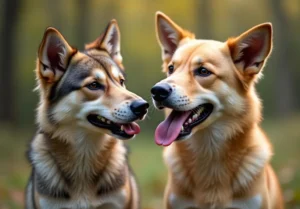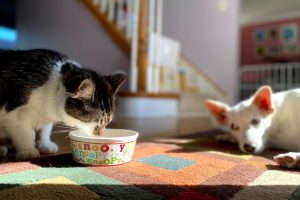Cats and dogs are both beloved pets, but have you ever noticed that cats tend to be fluffier than dogs? What’s the reason behind this common observation? Let’s find out.
Genetic Differences
Genetics play a significant role in determining why cats tend to be fluffier than dogs. The genetic makeup of each species has evolved over time to give them their distinct fur characteristics. Cats have specific genes that control the length and density of their fur, resulting in that luxurious fluffiness that many cat owners adore. On the other hand, dogs have different genetic factors that lead to their coat type, which is often less fluffy compared to our feline friends.
Evolutionary Adaptations
When it comes to the evolutionary side of things, cats have had to adapt to various environments over the centuries, which has influenced their fur density. Fluffy coats have helped wild cats stay warm in colder climates and provided better camouflage for hunting. Dogs, on the other hand, have evolved different traits that suit their roles as hunters, herders, or companions. This evolutionary history has shaped their coats to be more practical and functional, rather than fluffier like our purring pals.
Additional Insight:
One fascinating aspect of cats being fluffier than dogs is their grooming behavior. Cats are meticulous groomers, constantly licking and cleaning their fur to maintain its fluffiness and cleanliness. This grooming habit is essential for keeping their coats healthy and plush, adding to their overall fluffy appearance. So, besides genetics and evolution, a cat’s grooming routine also plays a crucial role in their fluff factor.
Grooming Habits
Cats and dogs have different grooming habits that contribute to the fluffiness of their coats. Cats are meticulous groomers, spending a significant amount of time each day grooming themselves with their rough tongues. This grooming helps distribute natural oils throughout their fur, giving it a soft and fluffy appearance. Additionally, cats have more hair follicles per square inch of skin compared to dogs, which also adds to their fluffy appearance.
On the other hand, dogs rely more on their owners for grooming, especially breeds with longer or thicker coats. Regular brushing can help prevent mats and tangles in a dog’s fur, but dogs generally don’t groom themselves as thoroughly as cats. This difference in grooming habits plays a role in why cats tend to have fluffier coats than dogs.
Climate and Environment
The climate and living conditions of cats and dogs can also impact the thickness and fluffiness of their coats. Cats are known for thriving in a variety of climates, from cold to hot, which has influenced the evolution of their coats to be thick and insulated. This adaptation helps them stay warm in colder environments and cool in warmer climates, resulting in a fluffy appearance.
Dogs, on the other hand, have a wider range of coat types due to their diverse breeding history. Breeds developed in colder climates, like Siberian Huskies, tend to have thick, fluffy coats to stay warm, while breeds from warmer regions may have shorter or thinner coats. Dogs’ coats can vary greatly depending on their breed and the climate they are adapted to.
Unique Insight : Pay attention to your pet’s coat and grooming needs based on the climate you live in.Adjust the frequency of grooming and type of care based on whether your cat or dog is more suited to hot or cold climates. Be mindful of how their environment can affect the appearance and health of their coat.
Breed Variations
When it comes to why cats are often fluffier than dogs, breed variations play a significant role. Certain cat breeds, such as the Maine Coon and Persian, are known for their luxurious and dense fur coats, which contribute to their fluffy appearance. These breeds have been selectively bred over generations to emphasize traits like long, thick fur, making them naturally fluffier than most dogs. On the other hand, while some dog breeds like the Samoyed or Pomeranian have fluffy coats, the majority of breeds have shorter, less dense fur, leading to cats generally being perceived as fluffier.
Moreover, cat breeds like the Ragdoll or Siberian have unique undercoats that are incredibly soft and dense, adding to their overall fluffiness. In contrast, many dog breeds have a single coat that may be thinner or coarser, contributing to a sleeker appearance. Therefore, the specific breeding histories and genetic makeup of different cat and dog breeds greatly influence their levels of fluffiness.
Unique Insight: When selecting a new pet, it’s essential to consider the grooming requirements of different breeds. Fluffier cats may need more frequent brushing to prevent matting and shedding, while dogs with shorter coats generally require less maintenance in this regard.
Seasonal Changes
Ever wondered why the fluffiness of cats and dogs can vary throughout the year? Seasonal changes in fur density are a key factor. Many cats undergo a process called shedding, where they lose their thick winter coat in preparation for the warmer months. During shedding season, cats may appear less fluffy as they naturally shed excess fur to regulate their body temperature. Conversely, dogs may also experience shedding but tend to maintain a more consistent coat density throughout the year.
Furthermore, some cat breeds, like the Norwegian Forest Cat, develop thicker winter coats to stay warm in colder climates, resulting in increased fluffiness during winter months. Dogs, on the other hand, may have a lighter coat year-round or grow thicker fur in response to colder temperatures, but typically do not experience the same dramatic seasonal changes as cats.
Overall, the seasonal fluctuations in fur density contribute to the differing levels of fluffiness between cats and dogs, with cats often appearing fluffier due to their shedding and coat adaptation processes.
As the seasons change, it’s essential to adjust your grooming routine to accommodate your pet’s evolving coat. Regular brushing can help manage shedding and maintain your pet’s coat health throughout the year.
Skin and Coat Health
Taking good care of your furry friends’ skin and coat is essential for maintaining their fluffiness. Regular grooming is key to keeping cats and dogs looking their best. Brushing helps remove loose fur, distribute oils, and prevent matting. Quality nutrition is also crucial for healthy skin and coat. Look for pet foods high in omega-3 fatty acids and protein to promote shiny, soft fur.
Interesting Facts
Did you know that cats tend to be fluffier than dogs because of their double-layered coat? The soft undercoat provides insulation, while the guard hairs protect against water and dirt. On the other hand, dogs typically have a single-layered coat, which can vary in thickness and texture depending on the breed.
- Cats have more hair per square inch than dogs, making them appear fluffier.
- The texture of a cat’s fur plays a significant role in their fluffiness. Some cats have long, silky fur, while others have short, dense fur that still creates a fluffy appearance.
- Dogs with curly or wavy hair, like Poodles or Bichon Frises, can also have a fluffy appearance due to the texture and thickness of their fur.
Plus, cats are known for their self-grooming habits, which help distribute natural oils and remove loose fur, contributing to their overall fluffiness.
The Human Factor
When it comes to the fluffiness of cats and dogs, the human factor plays a significant role. Through selective breeding practices, humans have influenced the evolution of both species, leading to variations in coat length and texture.
One reason why cats tend to be fluffier than dogs is due to the breeding goals set by humans. In the case of cats, many breeds were developed specifically for their luxurious fur, such as the Persian and Maine Coon. These breeds were selected for their long, dense coats, resulting in cats that are exceptionally fluffy.
On the other hand, dogs have been bred for a wide range of purposes, from hunting to herding to companionship. While some dog breeds, like the Samoyed or Pomeranian, have thick, fluffy coats, others have been bred for short, sleek fur. This diversity in breeding goals has led to a wider range of coat types among dogs compared to cats.
In addition to breeding practices, grooming habits also play a role in the fluffiness of cats and dogs. Cats are meticulous self-groomers, constantly licking their fur to keep it clean and well-maintained. This self-grooming behavior can help cats maintain their fluffiness by preventing matting and tangles.
On the other hand, dogs may require more frequent grooming to keep their coats looking fluffy. Regular brushing can help remove loose fur and prevent mats from forming, enhancing the overall fluffiness of a dog’s coat.
Overall, the human factor, including breeding practices and grooming habits, contributes to the differences in fluffiness between cats and dogs.
Unique Insight: Coat Density
When it comes to comparing the fluffiness of cats and dogs, another key factor to consider is coat density. Cats typically have a higher density of hair follicles per square inch compared to dogs, which contributes to their fluffy appearance.
This higher density of hair follicles allows cats to have more hair per square inch, resulting in a denser and fluffier coat overall. In contrast, dogs may have a lower hair follicle density, leading to variations in coat thickness and fluffiness among different breeds.
Alex, a passionate animal lover, has experience in training and understanding animal behavior. As a proud pet parent to two dogs and three cats, he founded AnimalReport.net to share insights from animal experts and expand his knowledge of the animal kingdom.




